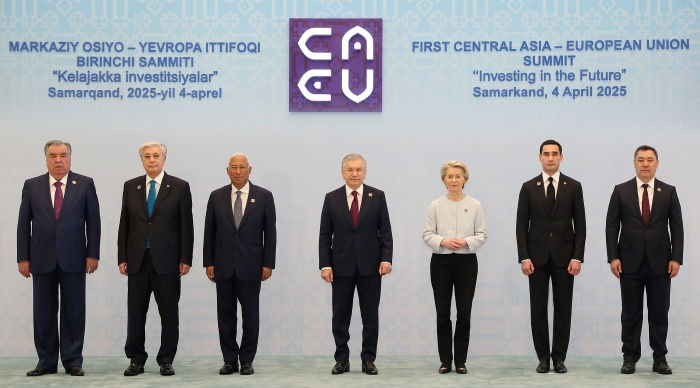Central Asia in and out
- Rashid
- Jul 8, 2023
- 4 min read
Updated: Jul 9, 2023
Keywords: Authoritarianism, decline, nationalism, class divides, border conflicts, water shortages, Russia, EU.
What to pay attention to in the region? Here I present some thoughts on three levels: internal, regional and international.
Internal
Authoritarianism. Central Asian (CA) regimes are focused on their own security and longevity. We will be seeing a growing number of referenda as the one taking place in Uzbekistan as we speak. These expensive acts of going through the motion of imagined democracy amid the absence of respective institutions or even values are simply taking place to justify the presidency for life. The sad part is that the international observers will say that it was a genuine choice of the people, and they will probably be right, given the absence of true competition. Other machinations include power inheritance a-la Turkmenistan. Something to expect in Tajikistan in the coming years.
Decline. The most tragic decline is taking place in Kyrgyzstan – a state with the strongest civil society that has been able to resent authoritarianism. Yet copy-pasted legislation from Russia and the mob rule are taking their toll. Freedom of (insert: expression, speech, protest, etc., etc…) is in severe decline.
Nationalism. From my own research on social media discourses, I observe a growing and worrisome discourse of hate. Sociological othering and hate pose a major regional security threat as everything else will crumble when people clash and refuse to reconcile.
Class divides. Amid the global inflation and local impacts on food prices, shortages and wage inequality inter-class tensions will also grow. Major cities, especially the capitals, are enclaves within the states. Life is very different not only beyond these cities but also within them. Consider the difference between Bishkek’s “golden square” and Ak Orgo; or Tashkent’s new “city” and Karakamish. This does not prevent the leaders from ambitious and suspicious projects of building smart cities. Rather remarkable to have a smart city in Turkmenistan where one must swear on Quran that they are not going to use VPN and in Kyrgyzstan where even the ”dumb” cities have no adequate infrastructure.
Regional
Central Asia has changed in the last 10 years. In 2013 we were talking about the water-rich upstream countries (Kyrgyzstan and Tajikistan) and the fossil fuel reach downstream countries (Kazakhstan, Turkmenistan, Uzbekistan). Now there are water shortages even in the north of Kyrgyzstan and Uzbekistan is buying gas from Russia.
Border conflicts. The root cause is water and land but the surface level is always inter-ethnic hatred. This is related to the point on “nationalism” above.
The arrival of people running from Russia. This leads to growing prices, again, related to the “class divide” above. Moreover, can we expect that at some point someone in the Kremlin will decide to “save” all these people through war (or whatever they will name it)?
International
Russia is still active and attractive. While the leaders of Central Asian states pretend to be neutral, their actions demonstrate that they are on board with Russia. May 9th military parade in Moscow with these special guests was a major symbolical illustration of this. There are a lot of agreements under the surface and business is business. The fact that official Tashkent asked Western states to be easy with sanctions on one of Russia’s wealthiest people Alisher Usmanov (originally from Uzbekistan and with close ties to Mirziyoyevs) illustrates that money comes first.
A major example of CA-Russia collaboration is the use of Russia’s face recognition technology and the exchange of personal data of citizens between Russia, Kazakhstan and Kyrgyzstan. Kyrgyzstan already detained and deported several dissidents back to Russia. Of course, CA is also used by Russia to circumvent Western sanctions.
Special attention must be paid to the fate of CA labour migrants in Russia as they are recruited into the armed forces either through carrot (the promise of a Russian passport and high salary) or stick (threat of deportation or simple kidnapping).
The role of Russian propaganda in the region must not be ignored as it is massive. Audiences in CA learn about the outside world through the lens of Russian propaganda. In this regard, there is a high risk that people will be alienated from Europe which is framed as a dangerous and amoral place. Anticolonial discourses are a growing trend and it is fantastic. Yet Russia is hijacking this discourse to demonise the West.
At the same time, Western states close their eyes on many injustices in the region with hopes to counterbalance Russia’s influence. This reminds me of the post-9/11 approach with the slogan - “These are dictators but they are our dictators” – which simply does not work. In the process of counter-balancing the “evil” it is important not to turn into everything one is fighting against.
Instead of appeasing the leaders who will take everything that is offered and then fly to Moscow to bow to the tzar, actors such as the EU should invest in the people of Central Asia. Realistically, this will imply simultaneous action as everything must be approved on the highest level in CA. However, people-to-people contacts are essential.





Perfect policy recommendation Rashid.
I also agree that authoritarianism has been the game in the town since time immemorial, not to Blame the USSR legacy. The Emirs and Khans were never more democratic than Russian/Soviets.
Disappointingly, Kyrgyzstan has seen democratic decay under Japorov. While I ask drivers in Bishkek. They say "when he was out of power, we loved him, but not now." This is self explanatory.
Class struggle is the real problem and it is growing, unfortunately. The real estate development in Bishkek is a more evident illustration of this reality.
While your final recommendation seeks policy change of the West toward the region, a follow up research work could help if it specifically mention in what areas the…